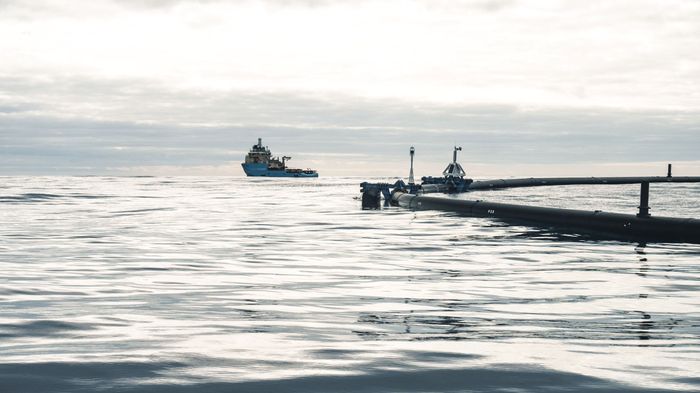
Testing Continues to Understand System Behavior
Back to updatesShift 3 has recently arrived at the System 001 location in the Great Pacific Garbage Patch (GPGP), where a series of tests will be conducted to help us understand why Wilson is not retaining plastic. Through this, we hope to learn as much as we can to be able to apply tactical solutions on Shift 4 (departing in five weeks).
STATUS UPDATE
We recently reported that System 001, or Wilson, is attracting and concentrating plastic, but not yet retaining it. This is a challenge we did not predict from our scale models nor prototypes. Eventually, the only way to truly see how the system would perform was to put it in the environment it has been designed for, and this application has largely been effective, since most of the design has withstood the tests of the Pacific, such as its ability to accumulate plastic, reorient with the wind and survivability. For the beta phase of a technology, this is already a success.
To prove our technology completely, we must overcome this challenge by identifying the cause and finding the right solutions. Next to its regular monitoring of the system’s performance, the crew on Shift 3 will explore possible causes, perform tests, and collect additional data to deduce the root of this issue.
After 6 weeks out at sea, our Shift 2 offshore crew completed its monitoring, data collection and research mission. Shift 3 crew just left port, carrying new equipment to further investigate the cleanup system’s behavior and make adjustments. Detailed update coming up next week. pic.twitter.com/VEepOwRDni
— The Ocean Cleanup (@TheOceanCleanup) December 13, 2018
SYSTEM SPEED
Of the possible causes, we believe – as shared with you earlier – the system might be travelling too slow to retain the plastic. It appears that the system occasionally travels slower than the plastic, which provides the caught plastic with the opportunity to leave the system again. With the goal of increasing its speed, Shift 2 performed an extension of the closing lines to widen the span and amplify the surface area that is propelled by the wind. We believed this might speed up the system, but this intervention turned out not to be effective.
We have observed plastic collecting within (and around) the system but then it drifts away, which can be in line with the speed differentiation explanation. Since Wilson was not affected by the closing line extension, we are going to attempt to achieve this effect by removing the closing lines and adjusting the locking line (the line that spans the width of the system at its opening). This would not be a permanent solution, but it might give us the desired outcome to learn more about this hypothesis.
Wilson Update: the closing line extension did not effectively increase the span of the system and, therefore, the speed did not improve. Further approaches to widen the u-shape are being evaluated and tested by the team. pic.twitter.com/YP3TFKmnGc
— The Ocean Cleanup (@TheOceanCleanup) December 4, 2018
The crew on Shift 3 might also conduct a tow test of the system in its U-shape configuration to mimic a speed increase. There are challenges expected with this test (such as the wake created by the Maersk Transporter), so we will conduct further analysis once the crew is in the GPGP and can determine if this is plausible or not.
INTERACTION EFFECT
Upon further inspection, Wilson might have a greater impact on the currents carrying the plastic than we initially projected. It looks as though various current effects are resulting from the system’s behavior in the water. For instance, there has been an observed a stagnation effect where small patches of plastic are driven around Wilson and accumulate on the exterior of the system. Alternatively, waves seem to be reflected or radiated at various points, which could affect the plastic’s ability to enter the ‘mouth’ of the cleanup system.
Observations and analysis of these interactions will enable us to understand the currents around Wilson.
Using a tracer dye, a type of dye used to observe flow, we will be able to see how the surface water flows in the vicinity of the system. These colored dyes are visually traceable and, in conjunction with a stabilized drone recording overhead and GPS drifters acting as debris, we will see how the water and, theoretically, the plastic move around the system. This dye is often used in rivers and other bodies of water for research purposes and is nontoxic and biodegradable.
To gather numerical data, we will deploy “Eve”, The Ocean Cleanup’s Autonaut vessel that is equipped with an Acoustic Doppler Current Profiler (ADCP), to measure the velocity of the water. Knowing the current speed will help us to determine the speed of the plastic and, thus, the speed difference between the system and the plastic.
Along with these tests, we will continue conducting more drifter tests to indicate a drifter that best mimics the route of the plastic, for further observations.
TEST, TEST AND TEST SOME MORE
We will continue testing and monitoring the system until we feel confident to make any modifications, if necessary, which will then be applied in a later shift. We are confident these tests will teach us more about the current status of Wilson, which will hopefully allow us to soon make the cleanup system fully operational.


